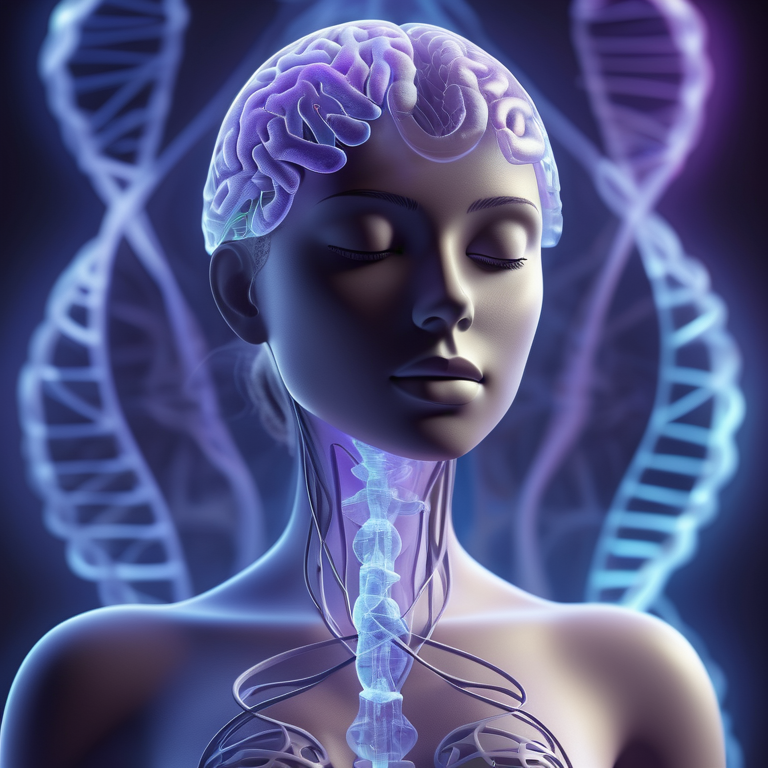Exploring Biopsychosocial Aspects of Female Sexuality

Key Highlights
- Female sexuality is influenced by a complex interplay of biological, psychological, and social factors.
- Hormonal can impact a woman’s sexual desire and libido, with fluctuations in testosterone and estrogen levels playing a role.
- Genetics also play a role in sexual health and behavior, with sex differences and variations in genes contributing to individual differences in sexual experiences.
- Psychological factors such as emotional well-being and body image can greatly influence a woman’s sexual confidence and desire.
- Social influences, including cultural norms and societal expectations, can shape a woman’s sexual behavior and expression.
- The sexual response cycle in women consists of four stages: desire, arousal, orgasm, and resolution, with variations and individual differences observed in each stage.
- There are common myths and stereotypes surrounding female sexuality that need to be debunked to foster a better understanding and acceptance of women’s sexual experiences.
- The biopsychosocial model provides a comprehensive framework for understanding female sexual dysfunction and the various factors that contribute to it.
- Therapeutic approaches, such as sex therapy and counseling, can help enhance female sexuality by addressing both the biological and psychological aspects of sexual health.
Introduction
The exploration of female sexuality is a complex and fascinating topic that encompasses a wide range of biological, psychological, and social factors. Understanding the biopsychosocial aspects of female sexuality can help shed light on the diverse experiences and challenges faced by women in regards to their sexual desires, behaviors, and overall well-being. This blog will delve into the key highlights of female sexuality, including the influence of hormones and genetics, the psychological dimensions of sexual health, the impact of social influences, the sexual response cycle in women, common myths and stereotypes, and the role of the biopsychosocial model in understanding and addressing sexual dysfunction. By gaining a deeper understanding of these aspects, we can foster a more inclusive and informed approach to female sexuality that promotes sexual well-being and satisfaction for all women.
The Complex Interplay of Biology and Female Sexuality
Female sexuality is a multifaceted aspect of a woman’s identity that is influenced by a myriad of factors. Biology, specifically the role of reproduction, undoubtedly plays a crucial role in shaping female sexuality, with genetic and hormonal factors contributing to sexual orientation, desires, and experiences. However, it is essential to acknowledge that female sexuality is not solely dictated by biology. The interplay of psychological and social elements also significantly impacts how women perceive and express their sexuality.
Psychological factors such as personal beliefs, past experiences, and emotional well-being can profoundly influence a woman’s sexual desires and behaviors. Additionally, societal norms, cultural expectations, and the media play a pivotal role in shaping attitudes towards female sexuality. These external influences can impact how women view their bodies, desires, and relationships.
By delving into the various dimensions of female sexuality, including biological, psychological, and social aspects, we can develop a more holistic understanding of what contributes to a woman’s sexual health and overall well-being. Acknowledging the complexity of women’s sexuality and related health issues can help healthcare professionals, researchers, and individuals themselves better support women in exploring and embracing their own sexual identities. It underscores the importance of promoting open dialogue, education, and empowerment surrounding women’s sexuality in order to foster healthy relationships and self-awareness.
Understanding Hormonal Influences on Sexual Desire
Hormones play a crucial role in a woman’s sexual desire and libido. Fluctuations in hormone levels, particularly testosterone and estrogen, can have a significant impact on a woman’s sexual desire. Testosterone, often associated with male sexual desire, also plays a role in women’s sexual desire. Studies have shown that women with lower testosterone levels may experience a decrease in sexual desire. On the other hand, estrogen, which fluctuates throughout a woman’s menstrual cycle, can influence sexual desire and arousal. Understanding the hormonal changes that occur throughout a woman’s life, such as during pregnancy, menopause, and hormonal contraception use, can provide insight into the variations in sexual desire experienced by women. By recognizing the hormonal influences on sexual desire and incorporating this knowledge into healthcare practices, healthcare professionals can better address and support women in maintaining a healthy and satisfying sex drive.
The Role of Genetics in Sexual Health and Behavior
Genetics also play a role in a woman’s sexual health and behavior. Research has shown that there are genetic factors that contribute to individual differences in sexual experiences and preferences. These genetic variations can influence a wide range of aspects, including sexual orientation, responsiveness to sexual stimuli, and the likelihood of engaging in certain sexual behaviors Additionally, there are sex differences in the genetic factors that influence sexual health. For example, certain genetic variations may be more strongly associated with sexual dysfunction in women compared to men. By understanding the role of genetics in sexual health and behavior, we can gain a better understanding of the individual differences and complexities of female sexuality.
Psychological Dimensions of Female Sexuality
In addition to biological factors, psychological dimensions are integral in understanding female sexuality. A woman’s emotional well-being, encompassing aspects like stress, anxiety, and depression, can profoundly affect her sexual desire and satisfaction levels. Furthermore, body image plays a crucial role in shaping a woman’s sexual confidence and willingness to participate in intimate activities. By addressing these psychological dimensions, it becomes possible to cultivate a healthy and satisfying sex life for women. It is essential to recognize the intricate interplay between physical and psychological factors when considering female sexuality. Therapeutic interventions that target both biological and psychological aspects can lead to holistic improvements in women’s sexual health and well-being. Initiating open conversations about emotions, body image concerns, and mental health can create a supportive environment where women feel empowered to explore and enhance their sexual experiences.
Emotional Well-being and Its Impact on Sexual Desire
Emotional well-being plays a significant role in a woman’s sexual desire. Factors such as stress, anxiety, and depression can negatively impact a woman’s desire for sexual activity. When a woman is experiencing emotional distress, it can be difficult for her to fully engage in and enjoy sexual experiences. Additionally, certain life events or circumstances, such as relationship issues or trauma, can further contribute to a decrease in sexual desire due to boredom. By addressing and managing emotional well-being, women can enhance their sexual desire and overall sexual satisfaction. This may involve seeking support from mental health professionals, practicing stress reduction techniques, and nurturing healthy relationships.
Body Image and Sexual Confidence: A Psychological Perspective
Body image, or how a woman perceives her own body and feels about her appearance, can greatly impact her sexual confidence. Women who have a negative body image may feel self-conscious and insecure during sexual activities, leading to a decrease in sexual confidence. On the other hand, women who have a positive body image and feel comfortable in their own skin are more likely to have higher levels of sexual confidence and enjoy a fulfilling sex life. Building a positive body image and improving sexual confidence can involve working on self-acceptance, developing a healthy relationship with one’s body, and cultivating self-esteem. Addressing body image concerns can help women feel more empowered and comfortable in their own skin, enhancing their overall sexual well-being.
Social Influences on Female Sexual Behavior
Social influences, encompassing cultural norms and societal expectations, wield considerable influence in molding female sexual behavior. The prevailing cultural norms concerning sexuality have the power to shape a woman’s beliefs, attitudes, and actions regarding her own sexuality. Insights from gender studies further illuminate the socialization process, revealing how societal expectations and stereotypes can impact a woman’s sexual encounters. Moreover, social factors can also sway decisions concerning sexual partners and the dynamics within these relationships.
Understanding the impact of social influences on female sexual behavior is paramount in comprehending the contextual elements that mold a woman’s sexual preferences and encounters. By acknowledging these factors, we gain insights into the intricate web of societal constructs that impact women’s choices in their sexual lives. This awareness opens pathways for more informed discussions and initiatives aimed at empowering women to make autonomous decisions about their sexuality.
Cultural Norms and Their Effect on Sexual Expression
Cultural norms and societal expectations have a significant effect on the way women express their sexuality. Different cultures have varying attitudes and beliefs about sexuality, which can shape a woman’s understanding and expression of her own desires and preferences. Cultural norms may influence the level of sexual openness and exploration that is deemed acceptable or taboo. These norms can also contribute to the perpetuation of stereotypes and gender roles, which can further limit a woman’s sexual expression. By challenging cultural norms and promoting open and inclusive conversations about sexuality, including topics such as masturbation and pornography, we can create a more accepting and empowering environment for women to express their sexuality freely and without judgment.
The Impact of Relationships and Communication on Sexuality
The quality of relationships and the effectiveness of communication within those relationships can have a significant impact on a woman’s sexuality. Healthy and satisfying relationships can contribute to a woman’s overall sexual satisfaction and well-being. Open and honest communication about desires, boundaries, and preferences can enhance intimacy and sexual pleasure. On the other hand, relationship issues, such as conflict or lack of emotional connection, can negatively affect a woman’s sexual satisfaction and cause discomfort. By fostering healthy and open communication within relationships, couples can create a supportive and fulfilling sexual environment that promotes intimacy and connection.
The Sexual Response Cycle in Women
The sexual response cycle in women is a complex process that involves four distinct stages: desire, arousal, orgasm, and resolution. Each stage plays a crucial role in the overall experience of sexual activity.
Desire is the initial phase characterized by sexual interest or motivation. It sets the stage for arousal, which encompasses both physical and psychological responses to sexual stimuli. Arousal leads to increased sexual excitement and readiness for further intimacy.
Orgasm marks the peak of sexual pleasure and release, often accompanied by rhythmic contractions of pelvic muscles. It is a culmination of heightened arousal and represents a moment of intense physical and emotional satisfaction.
Following orgasm, the resolution phase begins, signaling the return to a pre-arousal state. During this stage, the body gradually returns to its normal physiological state as sexual tension dissipates.
Understanding the intricacies of the sexual response cycle can empower women and their partners to communicate effectively, explore mutual desires, and enhance intimacy. By recognizing and respecting each stage of the cycle, individuals can cultivate a deeper connection and derive greater enjoyment from their sexual experiences.
Stages of the Sexual Response Cycle
The sexual response cycle in women consists of four stages: desire, arousal, orgasm, and resolution. These stages represent the sequence of physiological and psychological changes that occur during sexual activity. The desire stage involves the initial interest or motivation for sexual activity. Arousal follows, characterized by physical changes such as increased blood flow to the genitals and psychological responses to sexual stimuli. The orgasm stage represents the peak of sexual pleasure and release, accompanied by rhythmic contractions of the pelvic muscles. Finally, the resolution stage marks the return to a pre-arousal state, with a gradual decrease in sexual excitement. Understanding these stages, and the associated physiological changes, can help women and their partners navigate their sexual experiences and enhance sexual satisfaction.
Variations and Individual Differences in Sexual Response
While the sexual response cycle provides a general framework for understanding sexual experiences, it is important to recognize that there are variations and individual differences in how women experience and respond to sexual stimuli. Factors such as age, health, hormonal changes, and personal preferences can influence a woman’s sexual response. Some women may have a more rapid or intense response, while others may require more time or specific stimulation to reach the same level of sexual arousal or orgasm. It is crucial to acknowledge and respect these individual differences, including variations in sexual arousal, to ensure that women can fully explore and enjoy their own unique sexual experiences. By embracing and celebrating these variations, we can promote a more inclusive and fulfilling approach to female sexuality.
Addressing Common Myths About Female Sexuality
Female sexuality is a complex and diverse aspect of human behavior that is often shrouded in myths and stereotypes. These misconceptions can lead to misinformation, unrealistic expectations, and societal pressures on women. It is essential to address and debunk these common myths to foster a more accurate and understanding perspective on female sexuality.
One prevalent myth is the belief that women have lower sexual desire or are less interested in sex compared to men. In reality, libido levels vary greatly among individuals regardless of gender. Another misconception is the expectation that women should always reach orgasm during intercourse. The truth is that orgasms can be achieved through various forms of stimulation, including masturbation, and each person’s experience is unique.
Furthermore, the idea that all women experience sexual pleasure in the same way undermines the diversity of women’s sexual experiences. Every individual has different preferences, desires, and responses when it comes to intimacy. By challenging these stereotypes and promoting open conversations about female sexuality, including the use of vibrators for added enjoyment and variation, we can create a more inclusive and informed approach that celebrates the uniqueness of each woman’s journey.
Educating society about the complexities of female sexuality and encouraging discussions based on respect and understanding can help break down barriers and empower women to embrace their sexuality without judgment or shame. Embracing diversity in sexual experiences not only promotes healthier attitudes towards sexuality but also fosters greater intimacy, communication, and mutual satisfaction in relationships.
Debunking Myths About Female Sexual Desire
One common myth about female sexuality is that women have lower sexual desire or are less interested in sex compared to men. This myth perpetuates the idea that women should always be less sexually active or less interested in sexual activities than men. However, research has shown that women’s sexual desire can vary widely and is influenced by a range of factors, including hormones, stress levels, relationship dynamics, and personal preferences. It is important to debunk this myth and recognize that women’s sexual desire is diverse and can be just as strong and passionate as men’s. By challenging these misconceptions and understanding the biopsychosocial aspects of female sexuality, as explained by Lisa Diamond, a professor of psychology and gender studies, we can create a more inclusive and understanding society that respects and celebrates women’s sexual desires and experiences.
Challenging Stereotypes About Female Sexual Behavior
Another common stereotype about female sexuality is the belief that all women experience sexual pleasure and engage in sexual behaviors in the same way. This stereotype fails to acknowledge the diversity of women’s sexual desires, preferences, and behaviors, including their consumption of porn. Women have different sexual orientations, interests, and levels of sexual activity, just like men. It is important to challenge these stereotypes and recognize that women’s sexual behavior is individual and personal. By embracing and celebrating this diversity, we can create a more inclusive and empowering environment where women feel comfortable expressing their unique sexual desires and experiences without judgment or pressure to conform to societal expectations.
The Biopsychosocial Model and Female Sexual Dysfunction
The biopsychosocial model is a valuable framework that offers a holistic understanding and approach to addressing female sexual dysfunction. It recognizes the intricate interplay of biological, psychological, and social elements that can impact sexual health in women. Female sexual dysfunction encompasses a range of issues such as low libido, difficulties with arousal, pain during intercourse, or challenges in reaching orgasm. This can be influenced by various factors, including stress and high blood pressure levels, which can be examined through the Biopsychosocial model.
By adopting a biopsychosocial perspective, healthcare providers can pinpoint and tackle the diverse factors contributing to sexual dysfunction. These factors may include hormonal imbalances, psychological stressors, relationship dynamics, and societal influences. Through this comprehensive approach, tailored and effective treatment plans can be devised to support women grappling with sexual health concerns.
It is essential for healthcare professionals to conduct a thorough assessment considering all aspects of the biopsychosocial model when addressing female sexual dysfunction. This includes evaluating physical health markers, psychological well-being, and the individual’s social environment.
Furthermore, creating a safe and open space for women to discuss their concerns without judgment is crucial in providing effective care. Encouraging open communication about sexual health can help in identifying underlying issues and tailoring treatments that consider the unique circumstances of each individual. By addressing female sexual dysfunction through the lens of the biopsychosocial model, healthcare professionals can offer more comprehensive and personalized care to improve women’s overall well-being and quality of life.
Biological Factors in Sexual Dysfunction
Biological factors can contribute to sexual dysfunction in women. Hormonal changes, such as those experienced during menopause or pregnancy, can affect a woman’s sexual desire, arousal, and overall sexual function. Imbalances in hormones, including testosterone, estrogen, and progesterone, can lead to a decrease in sexual desire or changes in vaginal lubrication. Other medical conditions, such as diabetes, cardiovascular disease, or neurological disorders, can impact a woman’s sexual health, making it important to address these factors in the general population. It is crucial for healthcare professionals to work with women to identify and manage any underlying medical conditions or hormonal imbalances that may be contributing to sexual health challenges.
Psychological and Social Contributions to Sexual Issues
Psychological and social factors can significantly contribute to sexual issues in women. Psychological factors, such as stress, anxiety, depression, body image concerns, or past traumatic experiences, can impact a woman’s sexual desire, arousal, and overall sexual satisfaction. Social contributions, including societal expectations, cultural norms, or relationship dynamics, can also influence a woman’s sexual experiences. Addressing these psychological and social factors is crucial for understanding and addressing sexual problems in women. By providing support, education, and therapy, healthcare professionals can help women navigate these challenges and enhance their sexual well-being.
Therapeutic Approaches to Enhancing Female Sexuality
In addition to sex therapy, cognitive-behavioral therapy (CBT) and mindfulness-based interventions have shown promise in addressing psychological factors that can affect sexual function. CBT helps individuals identify and change negative thought patterns and behaviors that may be contributing to sexual difficulties. By working with a therapist, women can learn coping strategies and develop healthier attitudes towards sex and intimacy.
Mindfulness-based interventions, such as mindfulness meditation or yoga, can also be beneficial for improving overall well-being and reducing stress levels, which can have a positive impact on sexual function. These practices encourage individuals to stay present in the moment, fostering a greater connection with their bodies and sensations.
Furthermore, holistic approaches like acupuncture or herbal supplements may complement traditional therapies by targeting physical imbalances that could be impacting sexual health. It’s essential for women to explore various therapeutic options under the guidance of healthcare professionals to find a personalized approach that addresses their specific needs and concerns regarding female sexuality.
Biopsychosocial Interventions for Sexual Health
Biopsychosocial interventions provide a comprehensive approach to addressing sexual health concerns and sexual dysfunction in women. These interventions consider the biological, psychological, and social factors that may be contributing to sexual difficulties. Biologically-based interventions may involve hormone replacement therapy, medication, or other medical interventions to address hormonal imbalances or other medical conditions that may impact sexual health. Psychologically-based interventions, such as sex therapy or cognitive-behavioral therapy, can help individuals and couples address psychological factors that may be contributing to sexual dysfunction. Social interventions may involve education, relationship counseling, or addressing societal norms and expectations that may influence sexual health. By combining these biopsychosocial approaches, women can receive comprehensive and personalized interventions to improve their sexual health and well-being. References [ edit ] – ^ Jump up to: a b Nakao, Mutsuhiro; Komaki, Gen; Yoshiuchi, Kazuhiro; Deter, Hans-Christian; Fukudo, Shin (2020-12-08). “Biopsychosocial medicine research trends: connecting clinical medicine, psychology, and public health” . BioPsychoSocial Medicine . 14 (1): 30. doi :10.1186/s13030-020-00204-9 . ISSN 1751-0759 . PMC 7722433 . PMID 33292438 .
Counseling and Therapy Options for Sexual Dysfunction
Counseling and therapy can be beneficial for women dealing with sexual dysfunction. There are various counseling and therapy options available to address the underlying factors contributing to sexual difficulties. Individual counseling can help women explore any psychological or emotional factors that may be impacting their sexual function, such as stress, anxiety, past trauma, or negative body image. Couples therapy can be beneficial when sexual dysfunction is impacting the relationship dynamics and intimacy. Sex therapy, a specialized form of therapy, focuses specifically on addressing sexual difficulties and improving sexual function. This type of therapy may include education, communication exercises, behavioral techniques, and guidance on exploring and enhancing sexual pleasure. By seeking counseling or therapy, women can receive the support and guidance needed to address their sexual dysfunction and improve their sexual well-being.
Conclusion
Understanding the biopsychosocial aspects of female sexuality is essential for gaining insights into the complex factors that impact sexual health and behavior in women. Hormonal fluctuations, cultural norms, personal beliefs, and past experiences all contribute to shaping a woman’s sexual identity and experiences.
By dispelling myths, challenging misconceptions, and exploring therapeutic interventions, we can create a more inclusive environment that encourages open discussions and informed choices about female sexuality. Embracing the biopsychosocial model not only deepens our understanding but also informs strategies for improving sexual health outcomes among women.
Continuing this dialogue by sharing our knowledge and experiences on social media platforms can help raise awareness and empower individuals to embrace and celebrate the diversity of female sexuality. By fostering a supportive online community, we can break down barriers, reduce stigma, and promote holistic well-being for women everywhere.
Frequently Asked Questions
What is the Biopsychosocial Model of Female Sexuality?
The biopsychosocial model of female sexuality considers the complex interplay of biological, psychological, and social factors that influence a woman’s sexual health, sexual response, and overall experience of her own sexuality. It recognizes that female sexuality is multi-dimensional and involves a combination of physical, psychological, and social factors.
How Do Psychological Factors Affect Female Sexuality?
Psychological factors can have a significant impact on female sexuality. Factors such as emotional well-being, body image, self-esteem, and past experiences can influence a woman’s sexual desire, arousal, and overall sexual satisfaction. Addressing these psychological factors is crucial for promoting a healthy and fulfilling sex life for women.
Can Social Influences Alter Biological Aspects of Female Sexuality?
Yes, social influences can alter the biological aspects of female sexuality. Cultural norms, societal expectations, and socialization can shape a woman’s understanding and expression of her own sexuality. These social influences can impact a woman’s sexual behavior, desires, and overall sexual experiences.
How can biological factors impact a woman’s sexual experiences and desires?
Biological factors, such as hormonal changes, can impact a woman’s sexual experiences and desires. Fluctuations in hormone levels, such as testosterone and estrogen, can influence a woman’s sexual desire and overall sexual health. Understanding and addressing these biological factors is crucial for promoting a healthy and satisfying sex life for women.
How do societal and cultural influences affect female sexuality?
Societal and cultural influences play a significant role in shaping female sexuality. Cultural norms, societal expectations, and social norms can impact a woman’s sexual expression, desires, and overall sexual experiences. These influences can shape a woman’s attitudes, beliefs, and behaviors in regards to her own sexuality.





